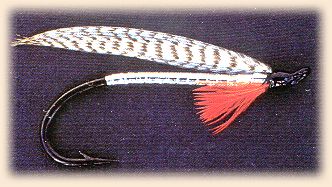Great Canadian Flies
Alevin, Yolk Sac or Egg 'n' I
By Arthur James Lingren

"I then got one of 2 pounds 11 ounces followed at intervals by two more of
two pounds 15 ounces & 2 pounds 1 ounce all on the same fly: grey mallard wing,
silver body 7 badger hackle. In the end I struck a fish & broke, losing my best
fly. I had several other rises & played a fish quite a time, later losing it . . .
The fish we caught were full of nymphs . . .also several alevins, some still showing
the sac."
So it was that Brayshaw recored in his angling diary entry on april 12, 1939, that the
Adams River's fry were still showing the yolk sac. The next day he recorded his
success with his newly developed pattern:
"Bright day with breeze from east. Started on left side of mouth at 9 a.m. I soon
was into one, a lovely thick fish which I lost just at the edge of the net. We were
very cold & I only got one of 2 1/4 pounds before lunch. After lunch on the right
side I got four more [2 pounds 5 ounces, 6 pounds, 2 pounds 15 ounches, 2 pounds
12 ounces] and lost one - the first one was on a size 8 and the others all on
size 6 mallard & silver with an Indian Crow feather tied in to represent
the yolk sac of the alevin."
On the following day he referred to this pattern as the Yolk Sac. But years later on a
1943 day when some of the British Columbian fishing legends of the day - Francis
Whitehouse, A. Bryan Williams and Brayshaw - were fishing the Adams River,
Brayshaw landed five rainbows totally 17 pounds 15 ounces on a fly he called
"Alevin." The dressing for the Alevin is identical to the Yolk Sac but with the
substitution of a white polar bear hair wing for the light mallard of the Yolk Sac.
Brayshaw often varied his winging material on his silver-bodied creations.
The fragile and now impossible-to-obtain Indian crow throat feather was later
replaced with a tuft of sockeye salmon-red wool. This change made the fly
much more durable and, with a name change from the Yolk Sac alias Alevin,
the Egg 'n' I was born.
Jim fisher of Vernon, in a 10 January 1995 letter about the Egg 'n' I says that
for March fishing on the Adams, "the Egg 'n' I is a tough fly to beat." Jim
prefers to dress his flies "with an egg sac of hot orange polypropylyne."
Details
Hook: Number 6 or 8 low-water salmon.
Body: Flat, silver tinsel.
Throat: Indian crow feather.
Wing: Slender strips of light mallard flank feather or white polar bear fur.
Originator: Tom Brayshaw.
Intended Use: Wet fly for rainbow trout.
Location: Little and Adams rivers.
~ Arthur James Lingren
Credits: From Fly Patterns of British Columbia
by Arthur James Lingren. We thank
Frank Amato Publications, Inc. for use permission!
Our Man In Canada Archives
|

